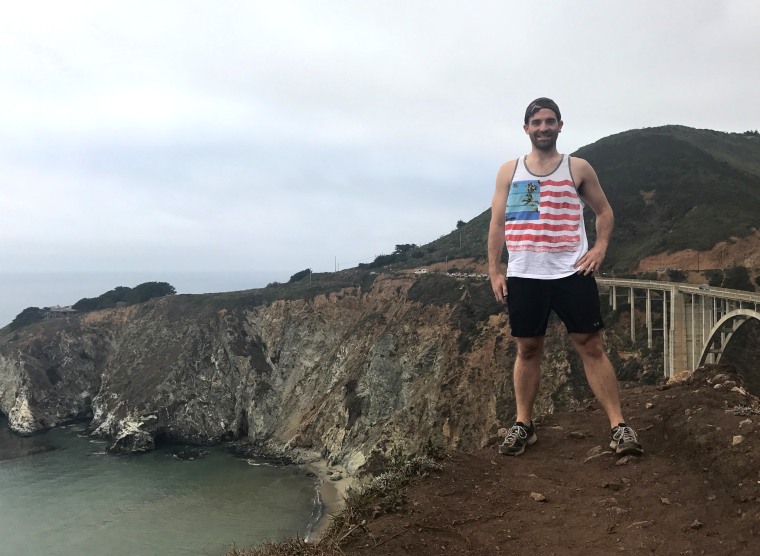Grammy- and Oscar-winning singer/songwriter Sam Smith, who is openly gay, fought back against body shaming last week with a shirtless Instagram post. He said it was the first time he didn’t starve himself “for weeks” before a photo shoot, even a fully clothed one.
The body-positive message drew widespread praise, but the platform for the message, Instagram, struck some gay men as ironic.
Instagram, which boasts roughly a billion users, is arguably the most visual social media platform, as its content is comprised of mostly photos and videos, with some memes sprinkled in. But for some users — particularly gay men, who have long dealt with social pressure to have a body that fits the "masculine ideal" — the image-centric platform has morphed from being a social network for friends to a sea of semi-nude “influencer” accounts.
These accounts, often dubbed “thirst traps,” typically feature scantily clad men with chiseled physiques hanging out on the beach or gay hot spots. They can have anywhere from 10,000 to a million followers, and they often post sponsored content where brands can promote their products. But this “eye candy” can have a negative consequence for some men who follow these accounts.
Patrick Lehe, 29, has struggled with his weight, including periods of binging and crash dieting. He said Instagram often reinforces the stereotype that gay culture is only for “ripped, statuesque men.”
At 6 feet tall, his weight has fluctuated between 188 and 277 pounds. He came out as gay after moving to Los Angeles, but he said because of his heavier weight, he feels even less accepted now than he did in the small town in Indiana in which he grew up.
“I’m at a healthier weight now, but it’s not one that is accepted by most in the community,” Lehe told NBC News. “Instagram helps create this idea that gay life is only for the ‘six-pack pals.’ I’ve felt this insecurity I couldn’t shake unless I fit the façade of beauty.”

Approximately 20 million women and 10 million men in the United States will have an eating disorder at some point in their lives, according to the National Eating Disorder Association. The organization found gay men struggle disproportionately with body image issues and eating disorders: Though they are thought to make up only 5 percent of the national male population, gay men account for 42 percent of men who report having an eating disorder.
Asher Pandjiris is a therapist in New York City who treats LGBTQ people with eating disorders and was also a program director at an eating disorder center. She said high rates of disordered eating in the LGBTQ community are often reactions to the homophobia internalized in youth.
“Queer people often try and prove heteronormativity by having a muscled or thin body,” Pandjiris said. “But it’s almost more insidious that the queer community polices or generates these unattainable standards.”
Pandjiris said it’s common to see patients engage in disordered eating, such as starving themselves if they miss a workout or before trips to gay events where their bodies are on display. She said looking at statuesque bodies on social media can play a hidden role in the problem.
“It’s hard for patients sometimes to connect the dots — that they saw a post on social media that makes them feel like they have to look a certain way in gay spaces, that they need to work out obsessively and starve themselves before a trip to Fire Island,” she said.
And research has indeed shown that high frequency of social media usage — particularly image-centric platforms like Instagram — corresponds to body image concerns and eating disorder symptoms in gay men.
Some of the ripped men on Instagram took note of Smith’s post. Max Emerson, whose page has more than a million followers, mostly posts photos of himself in his underwear, either alone or with other men with a similar physique.
Emerson, 30, said he’d like to feature more diversity on his page, but he said the reality is that posts with diverse bodies don’t get as much engagement.
“If you’re not selling a fantasy at first, you’re not going to get the platform,” he said. He pointed out that sponsors often cast his posts and that people with diverse bodies may not want to appear in photos with him, and that by keeping the platform popular, he's been able to raise significant funds for LGBTQ causes.
“Still, what Sam did is important,” he said. “I could do more.”
Lehe still follows a few “thirst traps,” but some gay men decide to cut them out altogether.
Patrick McNaughton, 35, said he unfollowed all such accounts about six months ago. When he joined Instagram in its nascent days in 2011, he enjoyed it as a way to keep up with friends.
“Eventually, it changed. It became hundreds, if not thousands of these hot guys posting pics,” he said.
McNaughton struggled with anorexia as a teenager and unhealthy diet and exercise later in life. He said that the photos of perfectly chiseled men on Instagram was an unwelcome reminder that in gay culture, it’s hard to get even platonic attention without that kind of a body.
“The photos are saying, ‘Look we’re all gorgeous, and we all hang out with people who look like us,’” he said. “If I saw those guys all together, they’d obviously never talk to me. So why maintain the fantasy by looking at the pictures?”
The way the men post about mundane aspects of their life — getting coffee, going to the gym, lying in bed reading — gives the false sense of real connection with them, according to McNaughton. “It’s like they are letting you into the elite social circle of hot guys,” he said.
Brogan, who has almost 50,000 followers and asked to be identified only by his Instagram handle to maintain a professional separation from his work at a startup, said he does feel connected to his followers. He said most messages he gets cite his feed as motivating, and he views Instagram as personally liberating.
For three years as a teenager, Brogan underwent conversion therapy in Virginia where he was told he was too feminine. He said this caused him to exercise obsessively in an effort to attain a physique perceived as masculine. “I looked great, but I was depressed,” he said.
Now, he’s found a balance in his diet and exercise, and is comfortable with his body. “I feel good when I’m walking around in my underwear,” he said. “I view the photos as art.”
When Brogan, 30, saw Smith’s post, he said he was surprised because he thought Smith looked great.
“I’d proudly stand next to him in photos. I don’t see our bodies as being in different categories,” he said. But he acknowledged that his feed doesn’t feature any men with physiques similar to Smith’s. The only posts showing diversity are a few with his friend, Mila Jam, a trans woman of color with an athletic physique and almost 20,000 followers.
“Do my photos with her make my engagements plummet? Yes. She’s a woman. My followers want a sexy man,” he said. “But I thought it was important to feature her.”
Padjiris, the therapist, said most people suffer in silence, creating the impression that this isn’t a widespread problem. She said it’s important for those with a platform to speak out, but ultimately the whole community could deal more honestly with the pressure on queer bodies.
“Smith said in his post it took courage to speak up. We could decide that we have a different standard of beauty, that we don’t have to conform to the heteronormative image,” she said. “That would be brave.”
If you struggle with disordered eating or someone you love does, contact the National Eating Disorders Association (U.S.) helpline at (800) 931-2237.


